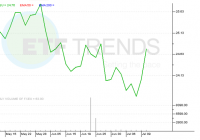4 Healthcare ETFs To Buy As Johnson & Johnson Beats Estimates
Original Post With the Q2 earnings season kicking off, Johnson & Johnson (NYSE: JNJ ) is the first to have reported earnings in the healthcare space. The world’s biggest maker of healthcare products continued its long streak of earnings beat despite currency headwinds and revenues that came in above our estimates. Further, the company lifted its full year outlook, reflecting confidence in its future growth. Johnson & Johnson Q2 Results in Focus Earnings per share came in at $1.71, a couple of cents above the Zacks Consensus Estimate but 3.9% below the year-ago earnings. Revenues slid 8.8% year over year to $17.8 billion but edged past the Zacks Consensus Estimate of $17.7 billion. Healthy sales of new drugs including Zytiga, Invokana, Imbruvica, and Xarelto and strength of old drugs such as Stelara, Concerta, Simponi and Invega Sustenna offset a steep decline in sales of the hepatitis C medicine – Olysio – which has lost its competitive position in the U.S. to its rivals Gilead (NASDAQ: GILD ) and AbbVie (NYSE: ABBV ). In spite of the fact that a strong U.S. dollar would remain a major drag on international revenue growth, the company raised its earnings per share guidance to $6.10-$6.20 from $6.04-$6.19. The new midpoint is above the current Zacks Consensus Estimate of $6.14. Market Impact Despite the earnings beat and encouraging guidance, shares of JNJ dropped as much as 1.7% on the day but recovered slightly to close at down 0.5%. This could be an attractive entry point for value investors given that Johnson & Johnson has a solid Value Style Score of ‘B’. Further, the stock has a favorable Zacks Rank #3 (Hold) and a solid industry Rank in the top 30% at the time of writing. ETFs to Buy That being said, investors could pile up some of the top ranked healthcare ETFs having the largest allocation to this behemoth for higher returns. We have detailed four of them below. All of them have a Zacks ETF Rank of 2 or ‘Buy’ rating, suggesting that they will outperform the market in the coming months. Health Care Select Sector SPDR ETF (NYSEARCA: XLV ) The most popular healthcare ETF, XLV follows the S&P Health Care Select Sector Index. This fund manages about $15.4 billion in its asset base and trades in heavy volume of more than 9.2 million shares. Expense ratio came in at 0.15% annually. In total, the fund holds 56 securities in its basket with JNJ taking the top spot at 9.51% of the assets. Pharma accounts for 42.9% share from a sector look while biotech, healthcare providers and services, and equipment and supplies make up for a double-digit exposure each. The fund has gained about 11.7% in the year to date time frame. iShares U.S. Healthcare ETF (NYSEARCA: IYH ) This fund provides exposure to 106 securities by tracking the Dow Jones U.S. Health Care Index. Here again, Johnson & Johnson dominates the fund’s return at 9.11% of total assets. In terms of industrial exposure, pharma takes the top spot at 41%, followed by biotech (23.2%), healthcare providers & services (16.3%) and healthcare equipment & supplies (15.2%). The product has amassed nearly $2.6 billion in its asset base while it charges 44 bps in annual fees. It trades in good volume of more than 23,000 shares a day and is up 13.8% this year. iShares U.S. Pharmaceuticals ETF (NYSEARCA: IHE ) This ETF targets the pharma corner of the broad healthcare space and tracks the Dow Jones U.S. Select Pharmaceuticals Index. Holding 39 stocks in its basket, Johnson & Johnson occupies the top position at 9.11%. Pharma takes the largest share at 85.7% while biotech takes the remainder. The product has managed nearly $1.2 billion in its asset base while volume is relatively light at under 56,000 shares a day on average. The fund charges 444 bps in fees per year from investors and has surged 20.9% so far this year. Vanguard Health Care ETF (NYSEARCA: VHT ) This ETF tracks the MSCI US Investable Market Health Care 25/50 Index and holds 349 stocks in its basket. Out of these, Johnson & Johnson takes the top spot with a 7.9% allocation. Pharma takes the largest share at 36.8% while biotech and healthcare equipment round off the top three spots. VHT is also one of the popular and liquid ETFs with AUM of $6.2 billion and average daily volume of over 297,000 shares. It charges 12 bps in annual fees and expenses. The product has added 13.6% in the year to date time frame.
